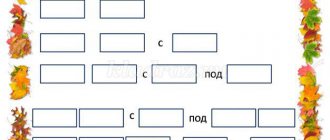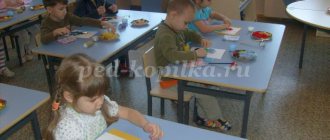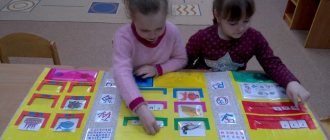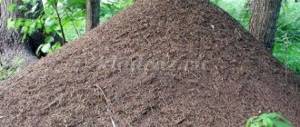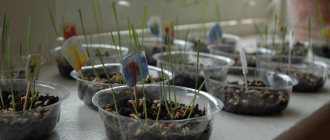Didactic games for children from 4 years old on the topic: “Trees and shrubs”
Didactic games for preschoolers on the topic: “Trees and shrubs”
Author: Knis Anna Nikolaevna, senior teacher. Place of work: MBDOU “Kindergarten No. 3 “Smile”, Kalach - on - Don. Description of work: I bring to your attention didactic games for preschoolers on the topic: “Trees and shrubs.” This material will help educators, children and their parents consolidate children’s knowledge about trees and shrubs in a playful way. Didactic game: lotto “Trees and Shrubs”.
Goal: To consolidate children’s knowledge about the variety of trees and shrubs, the ability to distinguish between them and find the right plant. Didactic material: Game field (4 pcs.), divided into 6 squares with images of various trees and shrubs, corresponding to the images on small cards (24 pcs.). Progress of the game: Game for children from 4 years old. The game can be played by 3-5 people. Players are given game cards. The presenter pulls out a small card from a special opaque bag, the player or presenter names the tree or shrub shown on the card. Whoever finds the corresponding image on his field takes the picture for himself. This continues until one of the participants covers the entire playing field with pictures. For children over 5 years old, the game can be complicated. Name in one word the trees or shrubs depicted on the same playing field.
1. Oak, birch, willow, linden, chestnut, maple are deciduous trees.
2. Bird cherry, lilac, mimosa, magnolia, rose hips, jasmine are shrubs.
3. Lemon, plum, pear, cherry, peach, apple tree are fruit trees.
4. Spruce, pine, cypress, juniper, thuja, and cedar are coniferous plants.
Didactic game “Guess the plant” Purpose: To develop the ability to describe trees and shrubs and recognize them by description. Didactic material: Cards with images of various trees and shrubs. Progress of the game: The teacher distributes cards with images of trees and shrubs to the children. Children do not show their cards to anyone. The teacher invites one child to describe what is shown in his picture, or to ask a riddle. The other children must guess what is in the picture. For example: This is a tree. It has white bark with black stripes. The branches hang down. In spring, sticky buds swell on them and catkins appear. This tree is considered a symbol of Russia. (Birch). I have longer needles than the Christmas tree. I am growing very straight, in height. If I'm not at the edge, the branches are only at the top. (Pine). Didactic game “Collect a picture” Goal: Development of logical thinking, outlook, cognitive interest and speech activity. Didactic material: Cards with images of trees and shrubs, cut into several parts. Progress of the game: Game for children from 4 years old. Children are given game cards cut into 3, 4, 5 parts (according to the age and abilities of the child). Having collected the picture, the child tells what he collected. For example: Oak is a tree. Acorns grow on it. Lilac is a bush with lilac flowers. Cards for cutting. Didactic game "The Fourth Wheel"
Goal: Development of skills to classify trees and shrubs according to essential characteristics. Didactic material: Cards depicting 4 types of trees and shrubs, 3 of them belong to one thematic group, and the fourth to another group. Progress of the game: Children are given the task: “Look at the pictures, name what is shown on them and determine which image is superfluous. Name the remaining images in one word.” Each participant eliminates the unnecessary image in turn. If he makes a mistake or does not complete the task, his version is offered to the next player to complete. For each correctly completed task they give a chip. The one who collects the most chips wins. For example: 1. Oak, alder, spruce and birch. The extra spruce is because it is a coniferous tree, and the rest are deciduous.
2. Alder, thuja, spruce, pine. The extra alder is because it is a deciduous tree, and the rest are coniferous.
3. Pear, peach, lilac, apple tree. The extra lilac is because it is a shrub, and the rest are fruit trees.
4. Mimosa, magnolia, lilac, birch. There is an extra birch because it is a tree, and the rest are shrubs.
Didactic game “What first, what then?”
Goal: ability to arrange pictures in order of plot development. Didactic material: A set of pictures for the game “What first, what then?”, four pictures in each series. Progress of the game: The teacher offers the children a series of pictures (four pictures for each child), which they need to carefully examine and determine what happened first and what happened next. “Which picture is first? What happened first? Children look at the pictures and arrange them in the required sequence. To check for accuracy, you can stick numbers on the back of the pictures. When the child lays out the sequence, he can check it himself by opening the pictures on the back side. Didactic game “Which tree is the leaf from?” Goal: the ability to distinguish and name the leaves of familiar trees. Didactic material: Cards depicting 4 types of trees and 4 leaves corresponding to these trees. Progress of the game: Invite the child to connect the leaves with trees of the corresponding type and name them. 1. Trees: cherry, peach, apple, pear. Leaves: cherry, apple, pear, peach.
2. Trees: maple, birch, willow, oak. Leaves: oak, maple, birch, willow.
3. Trees: chestnut, alder, spruce, linden. Leaves: alder, chestnut, linden, spruce needles.
We recommend watching:
Didactic games with sand for children 3-4-5 years old. Didactic games (verbal) for children 5-6 years old. Didactic game for children 6-9 years old. Fun vegetable garden Didactic game for younger preschoolers
Similar articles:
Didactic game “Collect a caterpillar” for children 5-6-7 years old
Didactic game “Find a Pair” for children 3-4 years old
Didactic game "Flowers" for children 5-6-7 years old
Didactic game for the development of fine motor skills of children 3 – 7 years old
Didactic game for preschoolers. Formation of ideas about time
Didactic game: “Autumn Adventure”, for children 4 - 7 years old
Author:Lyanguzova Olga Zhanovna
Position:
teacher - speech therapist
Place of work:
MKDOU No. 18, Miass, Chelyabinsk region
Purpose of the material:
the game can be used by specialists in working with preschool children aged 4 - 7 years, including for children with disabilities.
Equipment:
1 playing field, 9 pictures of leaves, 9 pictures of trees.
Goal:
development of observation, visual attention and memory
Objectives:
1. Activate children’s knowledge on the topic: “Autumn. Trees in autumn"
2. Develop the ability to form relative adjectives, develop basic mental processes.
3. Develop the ability to obey the rules of the game and play in a group of peers.
Form of organization:
individual or subgroup (2-3 people)
Preliminary work:
familiarization with the image of leaves and trees.
Progress of the game:
1 option
In front of the children there is a playing field of 9 sectors. Each sector contains 3 pictures depicting autumn leaves (chestnut leaf, oak leaf, willow leaf, aspen leaf, linden leaf, poplar leaf, rowan leaf, maple leaf, birch leaf).
The first move is determined by the counting rhyme:
"One two three four five.
We will collect leaves.
If you find a leaf,
I went first and played.”
If 3 children are playing, then each is given 3 pictures depicting single leaves.
The first player examines his leaves and the first sector on the playing field, if he finds among his leaves a similar one on the field, then he closes the sector with it and correctly names the leaf (chestnut leaf). Then considers the next sector. If the required sheet is not available, then the turn passes to the next player.
If there are 2 children playing, then we distribute 3 pictures to each and put 3 next to each other in a pile (with their shirts up) - “on the path.” The game is similar, but if the required sheet is not available, then it must be taken from the path. Only after this the turn passes to the other player.
The players' task is to get rid of their cards as quickly as possible.
The adult monitors the correct completion of the task and the formation of relative adjectives, correcting if necessary. If the child does not form the word correctly, he must stop and repeat the adjective correctly 3 to 5 times (maple, maple, maple)
Option 2
The game is played similarly to the previous one, with the only difference, instead of leaves, children are offered with images of trees. Thus, the task becomes more difficult, since children need to determine which tree the leaf comes from. In this version of the game, the child points to a leaf and introduces a relative adjective into the sentence: “A willow leaf from a willow tree.”
Making the game:
Word.
The picture material is taken from the Internet (links from sources are located below).
In the search engine we type the word CLIPART (picture on a transparent background) and the name of the picture. Select the required image, copy and paste it into the document. To remove the background, perform the following steps: WORK WITH THE DRAWING - REPAINT - SET A TRANSPARENT BACKGROUND.
So that the picture can easily move on the sheet, you need to click on the right mouse button, select OBJECT FORMAT - TEXT WRAP - BEFORE TEXT. The entire material can be downloaded from the “Download” link.

